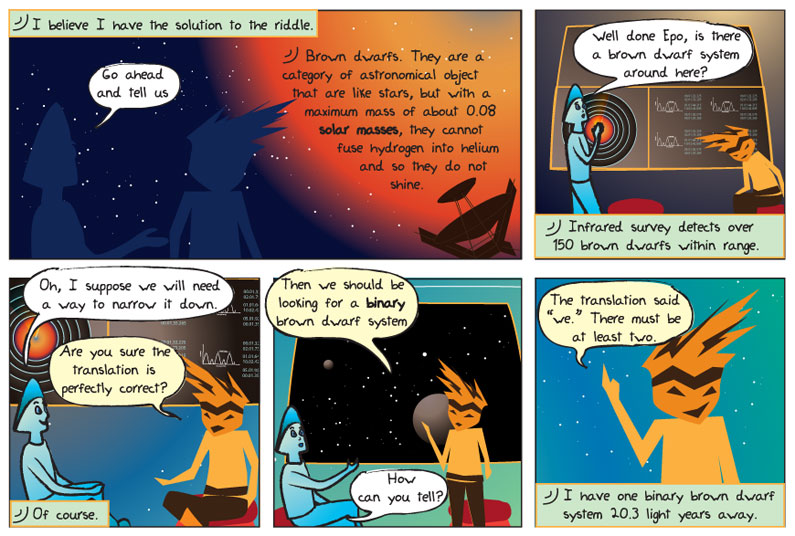
Transcript
Panel 1
Epo: I believe I have the solution to the riddle.
Alkina: Go ahead and tell us.
Epo: Brown dwarfs. They are a category of astronomical objects that are like stars but with a maximum density of 0.08 solar masses, they cannot fuse hydrogen into helium and so they do not shine.
Panel 2
Alkina: Well done, Epo. Is there a brown dwarf system around here?
Epo: Infrared survey detects over 150 brown dwarfs within range.
Panel 3
Alkina: Oh, I suppose we will need a way to narrow it down.
Beggrin: Are you sure the translation is perfectly correct?
Epo: Of course.
Panel 4
Beggrin: Then we should be looking for a binary brown dwarf system.
Alkina: How can you tell?
Panel 5
Beggrin: The translation said “we”. There must be at least two.
Epo: I have one binary brown dwarf system 20.3 lightyears away.
What does it mean?
Solar masses – This is the mass of our Sun, or about 2 x 1030 kilograms.
Binary – The word binary simply means there are two of something. When applied to a star system, it means that instead of having a single star, two stars orbit their common center of gravity.
Infrared – The band of the Electromagnetic Spectrum with wavelengths in the micrometer range.
In human speak please!
Brown dwarfs are a class of astronomical objects that scientists have recently been studying in detail. They have masses from around 12 to 80 times the mass of Jupiter, and are therefore intermediate in size between very large planets and very small stars.However, brown dwarfs do not have enough mass to generate internal temperatures high enough to spark nuclear fusion, which is what makes a star shine. Because they have a lot of mass, they contract gravitationally, producing heat that is emitted in the infrared part of the spectrum. Infrared is the region of the electromagnetic spectrum just below visible light in terms of energy, and objects that are somewhat hot (including mammals like us) give off infrared.

